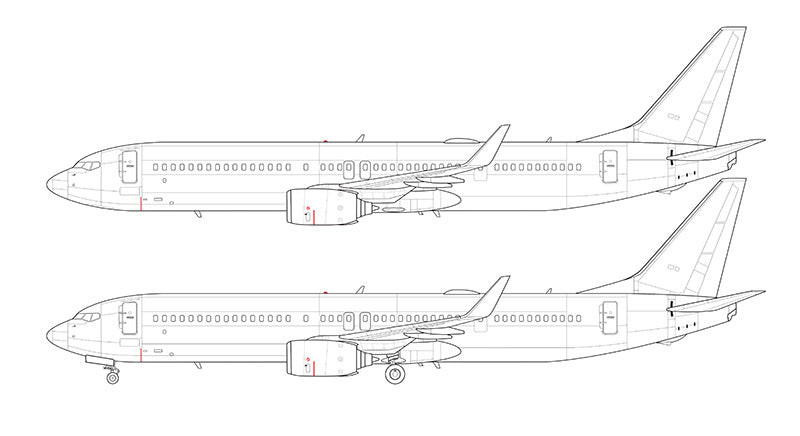
Boeing 737-900ER Overview
The Boeing 737-900ER is by far the most advanced narrow-body airplane in the world.
The Boeing 737-900 Extended Range stands as an upgraded and expanded iteration of the widely acclaimed narrow-body aircraft, the Boeing 737. Designed with the objective of augmenting both its range and passenger capacity beyond that of the base model 737-900, the 737-900ER incorporates advanced CFM International CFM56-7B27A/B engines, thereby extending its range to approximately 6,000 kilometers. This enhancement renders it particularly suitable for long-haul journeys, including transcontinental and intercontinental flights.
Furthermore, with its expanded cabin, the plane offers comfortable seating for up to 215 passengers in a single-class arrangement or up to 177 passengers in a two-class setup, making it the preferred option for airlines aiming to increase capacity on busy routes. Renowned for its efficiency and reliability, the Boeing 737 900ER remains highly coveted worldwide within its category. Its versatility in serving diverse routes and adaptability make it a favored selection for airlines striving to optimize their fleet while ensuring an elevated level of comfort and safety for passengers.
Boeing 737 900ER Development
The development of the Boeing 737-900ER dates back to the late 1990s, when Boeing began looking at ways to improve and expand its line of narrowbody airplanes. In response to the growing demand for higher capacity and longer-range airplanes, the company decided to create an expanded version of its successful Boeing 737-900.
The Boeing 737-900ER made its first flight in September 2006. This airplane was equipped with improved CFM International CFM56-7B27A/B engines, allowing for a significantly increased range over previous models. In addition, the 737-900ER had increased cabin capacity, making it an ideal choice for airlines looking to increase passenger numbers on popular routes.
Technology and Innovation 737-900ER
One of the key features of the Boeing 737 900ER is its ability to adapt to different operating environments. Both short domestic flights and long international flights can be operated with this airplane, making it a versatile and highly efficient aircraft in airlines’ fleets.
The Boeing 737-900ER is thus the result of a commitment to innovation and meeting the needs of the air transportation market.
Importantly, the Boeing 737 900ER also represents a significant step forward in cost efficiency and environmental sustainability. Improved engines and aerodynamic features reduce fuel consumption and emissions per unit of passenger carried, making it a greener option than previous models.
737-900ER Technical Details

Weights
| Max Takeoff Weight (kg) | 85,200 |
| Max Landing Weight (kg) | 71,400 |
| Empty Weight (kg) | 45,090 |
| Max Zero Fuel Weight (kg) | 67,800 |
| Max Payload (kg) | 26,720 |
| Fuel Tank Capacity (L) | 26,700 |
Dimensions
| Length (m) | 42.1 |
| Wingspan (m) | 34.3 |
| Height (m) | 12.5 |
| Wing Area (sq.m) | 125.0 |
Passenger Cabin
| Number of Seats (Economy) | 215 |
| Number of Seats (Economy/ Business) | 189 |
| Cabin Width (m) | 3.54 |
Performance Data
| Max Payload Range (km) | 5,900 |
| Service Ceiling (m) | 12,500 |
| Takeoff Distance (m) | 1,800 — 2,500 |
| Engines | CFMI CFM56-7B27, 2 x 12,260 kgf |
Boeing 737-900ER Seat Map
The Boeing 737-900ER tailors its service offerings to meet the preferences of individual airlines, typically providing a choice between economy class and business class, although the inclusion of Boeing 737-900ER first class may vary depending on the carrier.
In its standard setup, akin to many others in its fleet, the Boeing 737-900ER often excludes a first-class section. This decision aligns with its frequent deployment on medium and long-haul routes, where the demand for premium seating is typically lower compared to extended flights. However, select airlines may decide to introduce first-class amenities or other upscale services, responding to passenger preferences and strategic business considerations.
Business
Business Class in the 2-2 seating configuration of the Boeing 737-900ER seat map. Business aboard the Boeing 737-900ER delivers an enhanced travel experience, prioritizing passenger comfort and service over Economy Class. These seats boast expanded legroom and are outfitted with power outlets and USB ports for the convenience of charging laptops and electronic devices. Furthermore, they feature adjustable headrests, armrests, and reclining capabilities, ensuring passengers enjoy optimal comfort throughout their journey. Some aircraft variants may even offer fully lie-flat seats for added luxury.


Economy
Economy Class cabins on Boeing 737-900ER aircraft are designed with slim seats sporting ergonomic cushions to maximize passenger comfort. Strategically positioned literature pockets and enhanced overhead storage compartments contribute to a spacious and organized environment for travelers. Additionally, each seat is equipped with power and USB connections, catering to the modern traveler’s need for connectivity and convenience.
Comparison of Boeing 737 900ER Seat Maps
| Airline | Classes / Configuration | Total Seats |
|---|---|---|
| Alaska Airlines Boeing 737-900ER | First Class / 2-2 Economy Premium / 3-3 Economy / 3-3 |
178 |
| Delta Air Lines Boeing 737-900ER | First Class / 2-2 Economy Extra / 3-3 Economy / 3-3 |
180 |
| Korean Air Boeing 737-900ER | Business / 2-2 Economy / 3-3 |
159 |
| Oman Air Boeing 737-900ER | Business / 2-2 Economy / 3-3 |
183 |
| Turkish Airlines Boeing 737-900ER | Business / 2-2 Economy / 3-3 |
151 |
| Ukraine International Airlines Boeing 737-900ER | Business / 2-2 Economy / 3-3 |
215, 183 |



